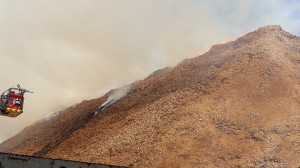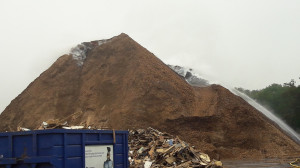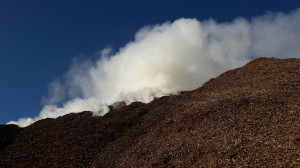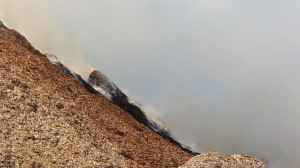At around 3○a.m., a deep-seated fire broke out in an outdoor 50,000○m3 woodchip storage in a waste recycling facility (24○m high, located on the facility’s property line). White smoke was emitted above the urban zone and the highway. Access to the site was difficult for the firefighters because of the volume of the stack. The wind propagated the flames. An expert specialised in deep-seated fires was called upon. The CASU (the INERIS Emergency Support Unit) was asked to provide models of smoke dispersion, given the possible human consequences in the vicinity. The presence of cyanide, phenol and benzene was detected.
Two days later, the fire brigade was confronted with the depletion of the drinking water supply for the municipality of 1,350 inhabitants. The inhabitants were invited to consume bottled water for a couple of days, the time required to resupply the community’s water tower and conduct the various analyses. The emergency services had to deploy 5○km of hoses, fed by a fire hydrant located in a nearby industrial estate.
Probes placed 2○m into the ground were used to take the temperature in the pile. Six-metre rods were used to collect chips at the heart of the heaps. A core drilling process was used to locate hot spots. The strategy adopted was to gradually flatten and spread the mound and water it down. The chips collected were then transported and unloaded on a vacant 4-hectare site located 3○km from the previously prepared and secured site. After 48○hours of cooling on this transit area, the burnt wood chips were sent to a storage facility or to a wood panel manufacturing plant.
Consequences
The intervention lasted nearly 4 weeks and required substantial human and technical resources (during the first week, 70 firefighters were deployed daily). The economic impact of the accident was serious. Post-accident analyses are being conducted on crops located in the fields near the site in association with the governmental agencies.
Causes
The cause of the accident was attributed to uncontrolled fermentation in the wood chip pile. The combined episodes of heat and rain preceding the accident accelerated this fermentation, creating pockets of gas and rising temperatures. The combustion started several weeks before the fire was detected, with no external sign.
The prefectural decree pertaining to the site indicates a maximum authorised tonnage of 5,120○m³ for all waste, including only 370○m³ for wood. But 50,000○m³ of wood chips were present on site. According to the operator, this overrun was due to a significant weakening of the wood industry (reduction in the consumption capacities of boilers and chipboard manufacturers).
Download the detailed report in .pdf format (539 Kb)








